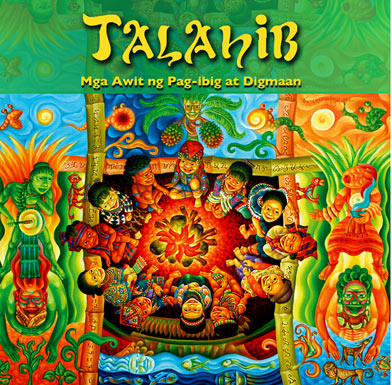Truth be told, we were given this “Talahib album: Mga Awit ng Pag-ibig at Digmaan” to review more than a month ago, but upon realizing that it's of an ethnic rock flavor, we've been shying away from writing about it, for fear that our jazz snob sensibilities might come to the fore and hold sway, and as a result, bash this band unfairly. So we chose to marinate our ears in this music for around a month, live with the album, so to speak, and give the music a chance to grow on us and win us over.

Talahib album cover: Art Direction by Max S. Baluyot; additional artworks by AG Saño "Dolphins Love Freedom"; Iggy Rodriguez "Forsaken Dreams"; Ianne Borillo "Bagyo"; and Ronald Castillo Malate "Worldmusic".
“Pag-ibig ang Pag-asa” is a cute little ditty with a shopworn but no less valuable a message. Given just a dash more gravitas, it might evolve from being a cute little ditty into being a pretty little ditty. In our spectrum of musical values, "cute" is the most trivial, most frivolous of accolades. Having said that, however, we hasten to add that Talahib's performance on this tune is competent and professional, with the rhythm section playing with good time and a solid groove, the vocals in tune and infectiously fun. “Bugaw” seems, on the surface, to be a throwback to both 70's era “Lolita Carbon” and Spanish-era kundiman. The guitar work on this tune is laudable— with banshee-like wails and pithy wah wah flourishes— as is the drumming, with its precocious percussive rim-shot punctuations. Repeated listening reveals a song with deceptive depth and more angles than are apparent at first listen. Our personal favorite track on this album has to be “Bumangon, Kaigorotan”, with its haunting vocal intro, languid guitar strumming and relaxed, easy feel. It has a deceptively catchy hook, and could with time become a full-fledged earworm that infects listeners with the dreaded LSS or last song syndrome. Of course, it should come as no surprise that this song is so catchy, as it seems to be a modern reinvention of the classic Pinoy standard, Salidumay. “Hiyaw”, another guitar strumming-driven ode, is vaguely reminiscent of early Corrs, with its six-against-four rhythmic scheme and airy, atmospheric vibe. With its catchy sing-along chorus, this is another solid commendable track. Good job, guys! With its groovy gong and perky percussion ensemble, solid harmonized vocals and lilting guitar passages, “Bathala” is another infectious track, a catchy paean to an early Filipino conception of The Deity. As a fellow guitarist, this listener must give props to guitarist Burn Belacho for serving up six-string passages as lyrical as they are deceptively virtuosic (i.e., trickier than they sound), with delectable little sweep-picked filigrees here and there. As guitarist and songsmith, Belacho is given to polyrhythmic acoustic guitar strumming. It's catchy and charming, calling to mind years of past youth. This endearing rhythm guitar style is again a hallmark of the tune “Babaylan”, which relates through song the soul of the sacred babaylan – essentially, female shamans/priestesses/oracles /wizards/leaders of early Filipino society. As we understand it, early Filipino society was governed by two main classes of leaders: the babaylan, or the shamans, who guided and vouchsafed the people's spiritual/mystical lives and the bagani, the warriors, who safeguarded the tribe's physical welfare. Ahhh, would that all anthropological treatises were this melodic! Students everywhere would all ace their HEKASI/SIBIKA classes! And leftist agitators would be denied their usual crop of impressionable young UP students, as everyone would be grooving to rockin' anthropology. The percussion ensemble makes a welcome reappearance in “Bagyo”, driving the track's ethnic rock jam in a lopsided groove that had us dancing up and down the aisles in an impromptu Ifugao jig. Without the requisite bahag (g-string), however, we soon sat ourselves back down to keep writing this review. The percussion ensemble again drives the ethno-rock of “On Potok”, which, contrary to our expectations and our instinct for puerile, juvenile scatological humor, is not a song about body odor or a need for deodorant. It does, however, feature a rockin' wah wah-laden guitar jam on the out-choruses, although the song as a whole might be a tad too raw for our tastes. “Mayad Pag-Surip” updates the ethnic instrumentation with cameo appearances by what seemed to our ears to be a Mountain Province nose flute, and a kubing (jaw's harp) or two. A meaty track, with an uplifting theme of hope and redemption ensconced in its Filipino lyrics, this song features another pithy guitar solo by Burn Belacho. Even by our admittedly snobbish standards, Burn Belacho is well-armed. He certainly scorches the six-string with nationalistic passion and ethno-rocking fervor. A word or two about nationalistic/patriotic stances applied to music: as a rule, it's usually a turn-off to our ears. We've never really been big fans of this kind of "tibak" (activist)-type of music. If you want to protest, then march down Mendiola! But if you want to play, just play! Music, by and large, should be left unsullied by mundane concerns, no matter how patriotic. Having said that, though -- it's to this band's credit that their politics tend to fly under the radar, so to speak. It's their music that speaks with the louder voice, thankfully. And now, having lived with this music, having submerged ourselves in it for the past month or so, and having come to the end of what has unexpectedly turned out to be a rave review of Talahib, thankfully, it's the music we retain, the music which rings in our inner ears, more than the politics. Viva, Belacho! Burn for president! Mabuhay!
— AC, GMA News [
Aya Yuson is arguably "the best guitarist of his generation, perhaps beyond". Despite his name, he is a dude. Despite his at times acerbic writing style, he is really rather personable. The views expressed in this article are solely his own.]





